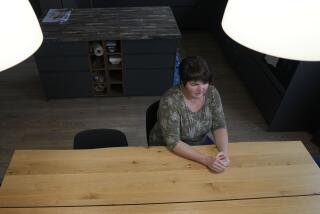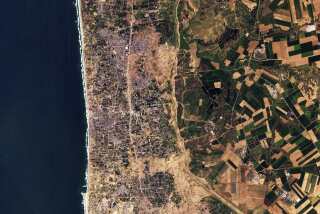Kosovo Buffer Is Danger Zone for Serbs
- Share via
MATAROVA, Yugoslavia — This is one place where Serbs have to be very careful not to wind up on the wrong side of the road.
About 200 Serbs live in this village in the buffer zone where southern Serbia comes face to face with the separatist province of Kosovo, and their rutted dirt road has suddenly become a dangerous borderline.
By the stroke of a map maker’s pencil, several of the Serbs’ houses are in Kosovo, under U.N. authority. But the farmers’ fields are across the road in Serbia proper, where Yugoslav President Slobodan Milosevic holds sway.
The split is more than just a strange quirk. It means that the Serbian villagers of Matarova, like thousands more living in the 482-square-mile buffer zone, are on the front line of a low-intensity border conflict that got worse when notorious Serbian troops withdrew from the zone and NATO-led peacekeepers came to Kosovo.
The buffer zone was created to prevent attacks by Serbian forces on peacekeepers and ethnic Albanians in Kosovo, but now Serbs complain that it has opened the door to ethnic Albanian attacks on them in the border area.
Last month, in the middle of the afternoon, arsonists set two of the Serbs’ houses on fire in Matarova. Villager Milos Kujovic, 44, blamed ethnic Albanians who, he said, frequently sneak past Scottish peacekeeping troops at a Kosovo checkpoint about a mile away.
The peacekeepers sent a firetruck, which put out the flames, but the ambulance that came with it was unnecessary, Kujovic said. The torched houses had been empty since July 1999, when a sniper killed Kujovic’s son-in-law on his doorstep.
Dejan Djordjevic, 25, was killed in front of his family’s house by a rifle shot that came from the ethnic Albanian village of Dubnica, on the Kosovo side of the road. The dead man’s family and neighbors all fled within the week, Kujovic said.
He and other Serbs interviewed in the buffer zone say tougher measures by foreign peacekeepers have improved security in recent weeks. But they say that they still hear gunfire in the night and that attacks are continuing.
“We are the next ones,” Kujovic said. “Our houses are the first ones to be exposed now. From here, there’s 207 meters [about 228 yards] to the borderline.”
From the dirt road that cuts through Borovac, a nearby Serbian village, Olivera Pavlovic, 33, said she frequently sees men in black looking through binoculars from the Kosovo Albanian villages of Mirovac and Livadica, about 300 yards away.
Three mortar bombs fell near the Serbs’ homes in Borovac about two months ago, and peacekeepers set up a ballistic tracking system to deter any more attacks, Pavlovic said.
But she still doesn’t feel safe, and she won’t till any of her land that is exposed to the Kosovo side for fear of being shot. In early July, four bullets were fired at the village in a border fight that started at 8:30 p.m. and went through the night, she said.
Land mines make the winding dirt tracks that twist along the border even more hazardous. Several Serbian police officers have been killed in land-mine explosions in the buffer zone, and two Serbian farmers from Kujovic’s village almost died the same way.
Their tractor tire just missed a mine laid in the dirt track, but the wheel of their trailer triggered it. The explosion blew the trailer to pieces, and the remains sit on display in Matarova, a constant warning of what might lie in wait.
“We don’t know if there are any more of those mines,” said Miloje Perovic, 69, a Serbian farmer in the buffer zone. “We don’t dare to venture on those roads anymore.”
In one of the latest reported attacks in the buffer zone, a candidate in a coalition with Serbia’s ruling Socialist Party was abducted and shot dead by five ethnic Albanians on Aug. 28, the party said in a statement.
The candidate, Milivoje Kankaras, and his wife were kidnapped from their home in Serbia, near the Kosovo border, and forced onto a tractor. As they approached the village of Velja Glava, the abductors threw the couple off the tractor and opened fire, killing Kankaras and seriously wounding his wife, the party statement said.
These attacks are occurring about 60 miles northwest of Serbia’s southeastern Presevo region, where a low-scale conflict between Serbian police and ethnic Albanian guerrillas has received the most attention.
The guerrillas, many of whom belonged to the now-disbanded Kosovo Liberation Army, call themselves the Presevo, Medvedja and Bujanovac Liberation Army after the three main towns in the area of Serbia that they want to unite with Kosovo, which is technically part of Serbia, the dominant Yugoslav republic.
In March, Secretary of State Madeleine Albright sent her then-spokesman, James P. Rubin, to Kosovo to try to persuade Kosovo’s newest guerrilla army, which then had an estimated force of about 150 fighters, to lay down its arms.
Rubin came away with an agreement from the ethnic Albanian rebels to disarm, but clashes with Serbian police units have continued.
The guerrillas insist that they’ve been forced to fight against Serbian repression of the fewer than 70,000 ethnic Albanians still living in southern Serbia proper. Serbs call the attacks “terrorism.”
At first, NATO-led forces monitored the clashes from across the border in Kosovo while the rebels and their supporters crossed freely into the buffer zone in the Presevo Valley through U.S.-controlled checkpoints.
In recent weeks, peacekeepers in Kosovo have increased measures to stop cross-border infiltrators. On Aug. 20, they arrested four suspected members of the new rebel army after stopping a black jeep linked to the disappearance of two Kosovo Serbs.
Meanwhile, the foreign troops are still struggling to stop ethnic Albanian attacks on Serbs and other minorities in Kosovo itself. Peacekeepers in central Kosovo were ordered to mount more mobile patrols Aug. 28, hours after an elderly Serb was shot dead in the northern Kosovo village of Crkvena Vodica.
In the same village, nine Serbian children playing basketball 10 days earlier were injured when an attacker threw two grenades onto the court as he drove past. The Serbian enclave is one of several guarded by heavily armed peacekeeping troops.
The new security measures came 14 months after North Atlantic Treaty Organization troops entered Kosovo following a 78-day bombing campaign to force the retreat of Serbian police and Yugoslav troops from Kosovo, where they fought a brutal yearlong civil war with separatist rebels in which ethnic Albanian civilians were the main targets.
Under the peace agreement that ended the NATO bombing last year, Yugoslav troops aren’t allowed within three miles of the Kosovo border and only lightly armed police can enter this buffer zone.
The accord, called the Military Technical Agreement, bans all personnel and organizations with a military capability from the buffer zone, including “special riot and anti-terrorist police.”
Yugoslav troops and police, numbering in the hundreds, are supposed to be allowed back intoKosovo to guard the border and cultural sites and help clear land mines, according to a separate clause of the agreement and U.N. Security Council Resolution 1244. But that part of the peace deal hasn’t been implemented.
Perovic, the farmer, would like someone to clear unexploded NATO cluster bombs from his fields so that he can go back to raising crops. But Perovic, who heads the village of Merdare next to the Kosovo border, said he has been told that Yugoslav troops aren’t allowed to come in to the buffer zone and clear the bombs.
Bozina Tosovic, 30, and his 11-month-old baby, Bojana, died in Merdare when a NATO cluster bomb opened over the village and released dozens of lethal “bomblets” on April 11, 1999, Perovic said last month.
A round canister about the size of a large cookie jar, with a white domed top, is still lodged in a bush behind Perovic’s house and leaves no doubt where the cluster bomb came from: “Department of the Navy, Naval Air Systems Command,” the black type reads. “Fuze proximity, dispenser FMU-140A/B.”
The cluster bombs, which look like soda cans with silver rods pointing out the top, lie scattered in Perovic’s fields, which are thick with tall weeds.
During the NATO bombing, “the army picked up the ones that were not activated, but there are still six poking out of the ground in my field,” he said before conducting a tour to point out the unexploded ordnance. “The whole container [of bomblets] fell on my yard. One of my cows was killed.”
More to Read
Sign up for Essential California
The most important California stories and recommendations in your inbox every morning.
You may occasionally receive promotional content from the Los Angeles Times.










